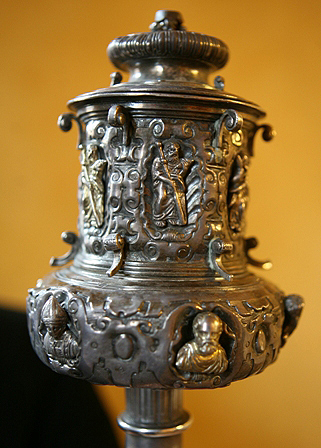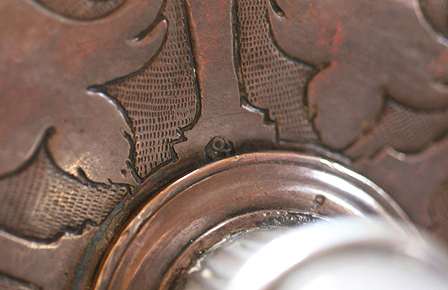The piece of the month of December 2009
MACE OR SCEPTER OF THE TOWN HALL OF OLITE
Ignacio Miguéliz Valcarlos
Chair of Navarrese Heritage and Art
The mace or scepter, as a symbol of authority, has been commonly used in the ceremonial and protocol of different institutions, as a sign of distinction and power. Its employment was significant throughout the 500s, and especially during the reign of Philip II, when they were commonly used by both civil and religious estates. These works, in imitation of the royal scepters but of larger dimensions, symbolized the power exercised by their owners, and given their larger size, they were carried or carried by ad hoc figures, the maceros, following a specific protocol , leading the retinues of the institutions to which they belonged when they participated in the different public events and processions organized in the city. Thus, depending on the importance of the celebration or act in which their use was required, the use of two, four or six maces could be arranged. Because of this, and when the owning institution was civilian, these pieces contained in a preeminent and clearly visible place, the arms of the organizations that had commissioned them. While in the case of religious institutions, the heads of the maces mainly featured figures of Saints and Apostles, as we can see in the scepters of the cathedral of Burgos.
In the town hall of Olite is preserved a mace or scepter (87 x / 5 cm) of gilded silver and in its color, datable to the last third of the sixteenth century, about 1575. Due to its iconography and the absence of the arms of the city, it leads us to believe that it would have arrived at the Olite regiment probably during the 19th century, during the disentailment process, coming from one of the parish churches of the city, perhaps that of San Pedro, for which we know that the silversmith author of this work had made a set of scepters.

Maza de Olite. Hernando de Oñate. C. 1575
This mace is conceived architecturally, and is articulated by means of a cylindrical barrel divided into four sections by rings, the last of which, which is richly decorated, has a small cylindrical fluted body that gives way to the head. This is tripartite, on a body in the form of a thick convex ring sits a cylindrical body followed, on a concave body, by another convex ring topped by a pedestal that has lost the element that would serve as a finial. This formal structure is inspired by the architectural macollas of the crosses of the same period.
It presents a rich Mannerist chiseled decoration that completely covers the last body of the barrel and the head. On the barrel, the ornamentation is arranged in the form of schematic flowers inscribed in almond-shaped elements. The head presents venerated niches framed by cut cartons that in the lower body house busts of bishops and saints, and in the upper body figures of apostles, all of them repeated and some of them gilded. The niches alternate with avolute ribs, which mark the fronts of the head.

Maza de Olite. Hernando de Oñate. C. 1575. Detail
It is stamped with the maker's mark o/H/OÑATE, a punch corresponding to the silversmith Hernando de Oñate el mayor, one of the most outstanding silversmiths in Navarre in the second half of the 16th century, with a rich production of which hardly any work remains, although there are numerous documentary reports. In 1579 Oñate made a commitment to the church of Ujué to make a set of four scepters, which were to follow the model of those made by the same silversmith for the church of San Pedro de Olite, and which had "baziado figures", such as those inscribed on the head of the scepter preserved by the Olite regiment, and which could be one of those made for the parish church of San Pedro. Likewise, in this piece we can appreciate decorative and iconographic motifs identical to those that appear in the ciborium of Tafalla, work of the same master.
This mace follows a formal outline very similar to that of other works of this same typology, following models of processional cross crests, as we can see in some maces from the Alorda Derksen collection, carved in Palencia in the second quarter of the 17th century. While other pieces of civilian character present greater differences in their conception, such as the maces of the city councils of Alcalá de Henares, Madrid or Toledo, in which the head is formed by a central stem to which are attached to the head, all of them inscribed with the municipal coat of arms of the cities to which they belong. Between both formulas are the maces of the city councils of Salamanca and Valladolid, datable like those of Olite in the last third of the XVI century, in which the head acquires architectural forms but that attach bichas and tornapuntas in that respectively, that are arranged radially.

Maza de Olite. Hernando de Oñate. C. 1575. Mark
bibliography
- CRUZ VALDOVINOS, J.M., Valor y lucimiento. Silverware in the community of Madrid, Madrid, 2005.
- ESTERAS MARTÍN, C., The Alorda Derksen Collection. Silverware of the XIV - XVIII centuries (Selected works), Madrid, 2005.
- HEREDIA MORENO, Mª.C. and ORBE SIVATTE, A., Biografía de los plateros navarros del siglo XVI, Pamplona, 1998.
- MALDONADO NIETO, Mª.T., La platería burgalesa: Plata y plateros en la catedral de Burgos, Madrid, 1994.
- ORBE SIVATTE, A., Platería del Reino de Navarra en el siglo del Renacimiento, Pamplona, 2000.
- VVAA, La platería en la época de los Austrias Mayores en Castilla y León, Valladolid, 1999.
- VVAA, El arte de la plata y de las joyas en la España de Carlos V, La Coruña, 2000.
